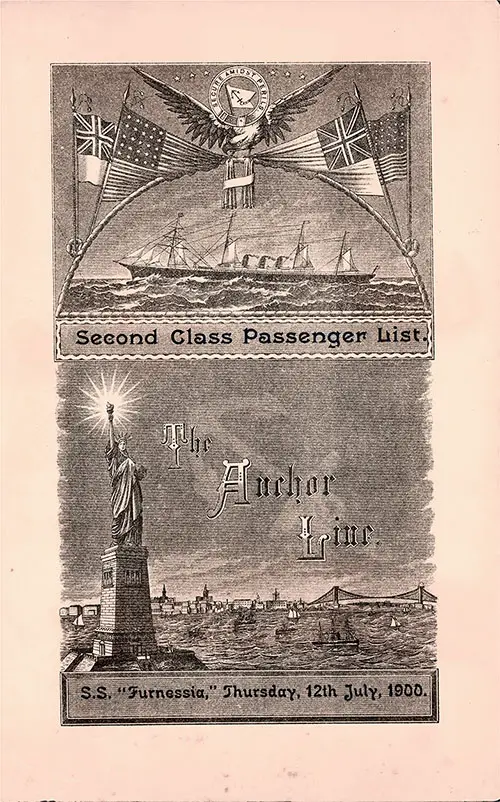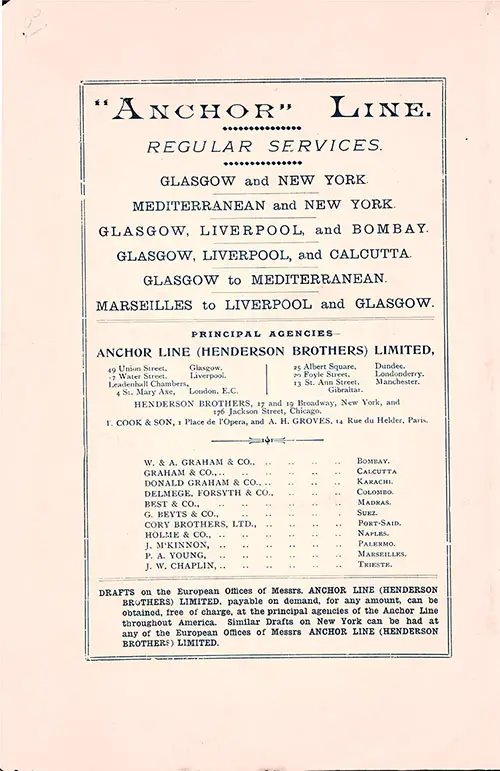Passenger List of the SS Furnessia – Anchor Line Voyage from Glasgow to New York, 12 July 1900

Front Cover of a Second Class Passenger List for the SS Furnessia of the Anchor Line, Departing Thursday, 12 July 1900 from Glasgow to New York, Commanded by Captain Hugh Young. Illustration Includes Anchor Line Logo, US and UK Flags, Line Art Drawing of the SS Furnessia, and a Scene in New York Harbor Featuring the Statue of Liberty. | GGA Image ID # 15b8fd0df9
🚢 Review & Summary – SS Furnessia Passenger List (12 July 1900)
Voyage Overview
On Thursday, 12 July 1900, the SS Furnessia of the Anchor Line departed Glasgow for New York, under the command of Captain Hugh Young.
Voyage Type: Westbound transatlantic crossing
Service Class Featured: Second Class
Seasonal Context: This midsummer sailing took place during one of the busiest transatlantic migration and travel periods, with Scotland’s urban centers and rural communities sending travelers to the United States for work, family reunions, or leisure.
The Ship – SS Furnessia
- Launched: 1880 by Alexander Stephen & Sons, Glasgow
- Gross Tonnage: ~5,500 tons
- Length: Approx. 445 feet
- Service Life: Regular Glasgow–Moville–New York service
- Operator: Anchor Line (later incorporated into Cunard)
Notable Features:
Steel-hulled, with a single funnel and two masts — a hybrid sail/steam design reflecting the transitional period of maritime engineering.
Popular among Second Class passengers — merchants, teachers, skilled tradespeople, and modestly affluent families — who wanted a comfortable yet affordable crossing.
Senior Officers and Staff
- Captain: Hugh Young, Commander
- Surgeon: F. H. Adamson
- Purser: David Bruce
- Chief Steward: Samuel Hiendry
- Matron: Miss Brodie
- Matron: Miss McCorquodale
Senior Officers & Staff
- Captain: Hugh Young – A seasoned Anchor Line commander, known for efficient and disciplined crossings.
- Surgeon: F. H. Adamson – Responsible for shipboard health, particularly important in the pre-antibiotic era.
- Purser: David Bruce – Managed shipboard transactions and passenger documentation.
- Chief Steward: Samuel Hiendry – Oversaw catering and comfort for Second Class travelers.
- Matrons: Miss Brodie and Miss McCorquodale – Provided moral supervision and safety for unaccompanied women and children.
Second Class Passengers
- Mr. John Aitken
- Mr. Robert Anderson
- Miss Christina Armour
- Mr. A. Arthur
- Mr. Ira De Bawn
- Mrs. De Bawn
- Miss Annetta De Bawn
- Mrs. William A. Beattie
- Miss Mary Bingham
- Mr. Arthur Bornstein
- Miss Mary Bright
- Mr. George Burns
- Mrs. Ellen Cameron
- Mr. Patrick Carr
- Miss Agnes Cooke
- Mrs. J. E. Collis
- Miss Margaret Craig
- Mr. R. Craigie
- Mr. D. Dallas
- Mrs. Dallas
- Miss J. Dickie
- Mr. Ronald Ferris
- Mr. Robert H. Fisher
- Miss Jane Fleming
- Miss Christina Fleming
- Master Adam Fleming
- Miss Jemima nett
- Mr. Charles Foulke
- Mr. Abraham D. George
- Mr. W. J. Gilchrist
- Mrs. Gilchrist
- Miss Lizzie Glen
- Mr. Isaac Goldsmith
- Mr. Robert Gordon
- Mrs. C. Gordon
- Mr. T. C. Graham
- Miss Ellen Grant
- Mrs. Janet Hall
- Miss Janet Hall
- Mr. Wm. Hamilton
- Mr. F: Haines
- Mr. Malcolm Heddle
- Mrs. Annie Holburn
- Mrs. Annie M. Inglis And Infant
- Miss Rose B. Jolly
- Mr. James G. Kirkwood
- Mr. John Leckey
- Mr. John Leonard
- Mr. Terence Leonard
- Mr. A. K. Lodge
- Mr. Nicol Love
- Mrs. Margaret McAllister
- Mr. Michael McAllister
- Mr. John McAllister
- Mr. John McBurnie
- Mr. E. McCaffrey
- Mr. James McCormack
- Mr. Peter McCormick
- Mrs. Mary McDermott
- Mr. Thomas McDermott
- Mr. James McFarlane
- Mrs. A. McFarlane
- Mr. Wm. McFarland
- Miss Annie McGoldrick
- Mr. John McGovern
- Miss Janet McIsaac
- Mrs. J. Mackenzie
- Mr. Wm. McMullan
- Mr. J. McQuillan
- Miss Lizzie McQuillan
- Mrs. H. C. Mack
- Mr. James B. Magee
- Mrs. Mair
- Miss Mair
- Mr. Morris Malloch
- Miss Jane Millar
- Mrs. Thomas Milne
- Miss Lizzie Milne
- Miss Eleanor Milne
- Mr. George Morrison
- Mr. Joseph Murray
- Mr. Oscar Nemitz
- Mr. James O'Neill
- Mr. Richard Osborne
- Mrs. Parker
- Mr. William Parker
- Mr. James Paterson
- Mr. Robert Patrick
- Mr. Robert Pringle
- Mrs. Rachel Pringle
- Mrs. Martha Pringle
- Mrs. Ralston
- Mr. Harvey C. Reynolds
- Mr. Samuel Reynolds
- Mr. John T. Rutherford
- Mr. Gilbert Shaw
- Mr. William Simpson
- Mrs. Simpson
- Mr. John Spalding
- Miss Bessie Spencer
- Mr. Joseph Small
- Mrs. Sarah E. Stevenson
- Master Robert Taylor
- Master Thomas Taylor
- Mr. George Thorns
- Mrs. Margery Watson
- Miss Margery Watson
- Mrs. William Watson
- Mr. William Watson
- Mr. Matthew F. Watson
- Mr. Andrew T. Walker
- Mr. Robert J. Walker
- Mr. Leon Westmoreland
- Mrs. John Westwater
- Mr. Charles Williams
- Mrs. Alice Wilmot
- Miss B. Wilmot
- Miss Mary Wilson
- Mr. Allan H. Wright
- Mrs. Robert Young
- Mrs. Younger And Infant
Notable Passengers & Social Context
This voyage reflects the rich tapestry of Second Class travel at the dawn of the 20th century. While primarily composed of working- and middle-class Scots and Irish, the list reveals professionals, merchants, and families engaged in transatlantic life.
🎓 Academic & Professional
Mr. Arthur Bornstein – Likely engaged in mercantile or import/export business; Second Class was favored by commercial agents traveling between Britain and the US.
🕊 Religious & Community Leaders
No major clergy are explicitly listed on this particular voyage, but the presence of multiple family groups with maternal leadership — e.g., Mrs. Margaret McAllister and Mrs. Annie M. Inglis — is consistent with church-affiliated migration sponsorships common in 1900.
🌍 Global Travelers
Mr. Oscar Nemitz – Surname suggests German or Central European heritage; may represent transnational movement beyond the British Isles.
Mr. Leon Westmoreland – Possibly connected to US or British colonial administration, given the period’s global travel networks.
👪 Prominent Family Clusters
The McAllister Family – Multiple McAllisters on board, indicative of family migration or return visits.
The Watson Family – Three entries (Mrs., Miss, and Mr. Watson) traveling together, suggesting intergenerational travel.
Drafts on the European Offices of Messrs. Anchor Line (Henderson Brothers) Limited, Payable on Demand, for Any Amount, Can Be Obtained, Free of Charge, at the Principal Agencies of the Anchor Line Throughout America. Similar Drafts on New York Can Be Had at Any of the European Offices of Messrs Anchor Line (Henderson Brothers) Limited.
The Most Engaging Elements of this Passenger List
The July 1900 Furnessia manifest stands out for:
- Its mid-summer timing, capturing seasonal migration and vacation travel.
- A passenger mix that blends merchant-class mobility with family emigration patterns.
- Glimpses of early 20th-century globalization through non-Scottish names like Nemitz and Bornstein.
Noteworthy Images 📸
Front Cover – A richly illustrated design featuring:
- The Anchor Line logo flanked by the US and UK flags.
- A line-art profile of the SS Furnessia.
- A vignette of New York Harbor with the Statue of Liberty — symbolic of opportunity and freedom for westbound travelers.
Back Cover – Promotional text detailing Anchor Line services and a global network of principal agencies, showing the company’s international reach in the steamship era.
Relevance for Teachers, Students, Historians & Genealogists ✍️
Genealogists – Valuable for tracing Scots, Irish, and Central European emigrants or visitors in the early 20th century.
Historians – Offers insight into the role of Second Class travel as the "middle ground" between luxury and economy.
Students – A primary source for projects on migration, maritime economics, and the social history of transatlantic travel.
Maritime Enthusiasts – Reveals how the Furnessia and the Anchor Line positioned themselves competitively against larger rivals like Cunard and White Star.
Final Thoughts – Why This Passenger List Matters ⭐
The 12 July 1900 crossing of the SS Furnessia represents a transition point in maritime and migration history — the Victorian era’s twilight and the Edwardian age’s dawn. The voyage carried skilled workers, merchants, and families seeking economic opportunity, educational advancement, or simply a return to their American homes after visits abroad.
This passenger list is not just a record — it’s a social snapshot of global mobility in 1900, preserved in a document that reflects the artistry, branding, and corporate reach of the Anchor Line.

Anchor Line Services and Principal Agencies on the Back Cover of a Second Class SS Furnessia Passenger List , 12 July 1900. | GGA Image ID # 15b928f853
📜 Research note: Some names and captions were typed from originals and may reflect period spellings or minor typographical variations. When searching, try alternate spellings and cross-check with related records. ⚓
Curator’s Note
For over 25 years, I've been dedicated to a unique mission: tracking down, curating, preserving, scanning, and transcribing historical materials. These materials, carefully researched, organized, and enriched with context, live on here at the GG Archives. Each passenger list isn't just posted — it's a testament to our commitment to helping you see the people and stories behind the names.
It hasn't always been easy. In the early years, I wasn't sure the site would survive, and I often paid the hosting bills out of my own pocket. But I never built this site for the money — I built it because I love history and believe it's worth preserving. It's a labor of love that I've dedicated myself to, and I'm committed to keeping it going.
If you've found something here that helped your research, sparked a family story, or just made you smile, I'd love to hear about it. Your experiences and stories are the real reward for me. And if you'd like to help keep this labor of love going, there's a "Contribute to the Website" link tucked away on our About page.
📜 History is worth keeping. Thanks for visiting and keeping it alive with me.
